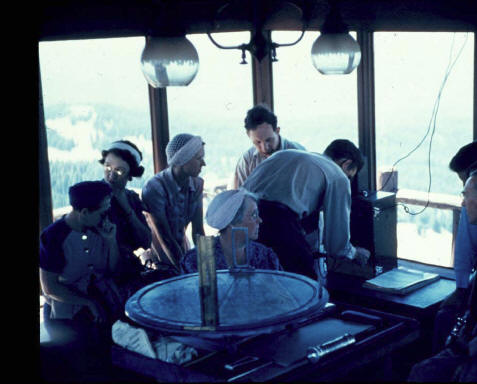National Park Service Cultural Landscapes Inventory: The Watchman, Crater Lake National Park, 2001
Physical History
1942-1971
Throughout the war years and into the 1950s, Watchman Observation Station was staffed during the fire season and utilized for interpretive purposes (Greene, 1984, 249-50). With only one exception in 1947 due to personnel shortages, the guided auto caravans led by Ranger-Naturalists continued to circumnavigate the caldera during summer (Ruhle, 1947). By 1948 the guided auto caravans were documented as operating much as they did during the 1930s (NPS, Naturalist Program, 1948). Even well into the 1950s, “the park interpretive program at Crater Lake continued to emphasize the activities that had been initiated both before and immediately after WWII.” (Unrau, 1988, 657).
During the Mission 66 era, Watchman Observation Station remained a popular attraction for park visitors and was considered for new development. This plan represented a change in park philosophy. Development focused on recreational opportunities rather than new or alternative interpretive opportunities. Park planners considered incorporating new winter sports areas in various places at Crater Lake and specifically mentioned development of this kind to be sited at Watchman Peak (Unrau, 1988, 498). Although a specific winter sport program was not identified, it is likely that downhill skiing was the sport. Other construction and development plans included an extension of the viewing platform at the Watchman Overlook and an updated sewer system (Unrau, 1988, 511). These amenities were intended to improve the visitor experience in the park and enable people to come in to “close contact with nature”. Plans for recreation were never implemented, however the additional infrastructure was implemented (Unrau, 1988, 606).
Interpretive displays at the museum were proposed by Hall in 1936. The plan called for the placement of eight display cases. Their dimensions included six 6’-7’ cases and two 2’ cases. The exhibits proposed the following topics:
- Forests of Crater Lake National Park, Nature and Composition.
- Forest Protection: Scope and General Management.
- Insects Harmful to Forests.
- Fungi and Other Plants Harmful to Forests.
- Causes and Prevention of Forest Fires.
- Detection of Forest Fires
- Fire Suppression
- Results of Forest Fires (Unrau, 1988, 655).
Although these additions were not incorporated at the museum until 1962, Watchman Observation Station continued to gain in popularity during the years before WWII. Visitation at the national park reached a record all-time high at 273,564 in 1941. At this time major trails were ordered in popularity, Watchman Trail was found to be second only to the Crater Wall Trail leading to the lakeshore (Unrau, 1988, 592).
 |
| Historic photograph from the 1960s showing Ranger-Naturalist educating park visitors about Crater Lake (CRLA slide files). |
Other pages in this section

